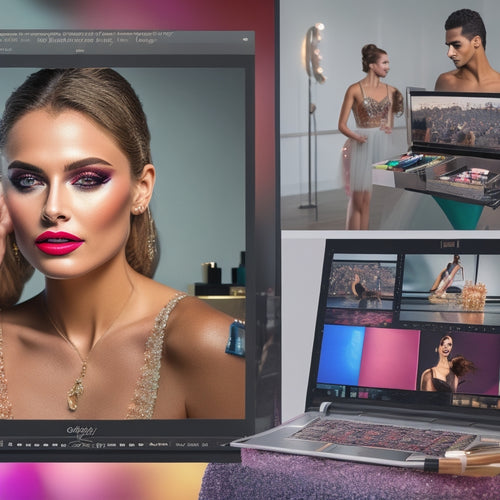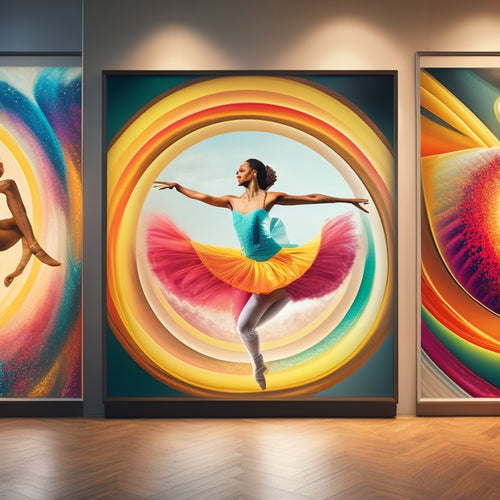
What's the Best Music Editing Software for Choreographers?
Share
As a choreographer, you require music editing software that can seamlessly adjust tempo, time-stretch, and pitch-shift to bring your creative vision to life. Look for software with essential features like tempo control, time-stretching, and pitch-shifting capabilities. Top picks like Adobe Audition, Ableton Live, and Logic Pro X offer advanced tools, but user-friendly options like Audacity and GarageBand are also available. Consider your needs, budget, and skill level when choosing software. With the right tools, you'll be able to craft immersive audio experiences that elevate your choreographed performances. Now, explore your options and discover how to take your choreography to the next level.
Key Takeaways
• For choreographers, essential features in music editing software include tempo control, time-stretching, and pitch-shifting capabilities for seamless atmosphere matching.
• User-friendly options like Audacity and GarageBand provide intuitive interfaces for beginners, empowering them to focus on choreography without technical complexities.
• Advanced tools like Ableton Live and Logic Pro offer unparalleled creative freedom, featuring real-time music improvisation and collaborative workflow capabilities.
• Budget-friendly software options like Audacity, Ocenaudio, and GarageBand provide basic editing tools and advanced effects, allowing for high-quality music edits on a budget.
• Beat matching essentials and rhythm adjustment tools are crucial for syncing music to dance routines, enhancing the visual impact of choreography through seamless tempo and rhythm alignment.
Essential Features for Dance Tracks
When crafting a dance track, you'll want to make sure your music editing software can deliver essential features that meet the choreographer's creative vision, including tempo control, time-stretching, and pitch-shifting capabilities.
A good dance tempo is vital, and being able to adjust it seamlessly is a must-have feature. Imagine having to redo an entire routine because the music is too fast or too slow - not ideal, right?
With tempo control, you can guarantee the music atmosphere is perfect for the choreographer's vision. Time-stretching and pitch-shifting capabilities also come in handy when you need to make adjustments on the fly. Want to create a dramatic buildup or a smooth transition? These features got you covered.
Additionally, they allow for more creative freedom, enabling you to experiment with different sounds and moods. By having these essential features at your fingertips, you can focus on what matters most - creating an unforgettable dance experience.
Top Picks for Music Editing
As you begin to explore the world of music editing, you'll want to start with the basics of audio editing and understand the fundamental concepts that will help you make informed decisions about the software you choose.
Next, you'll want to compare the features and capabilities of different music editing software options to find the one that best fits your needs as a choreographer.
Audio Editing Basics
You'll need a solid understanding of audio editing basics to effectively edit music for your choreography, and a good music editing software is essential to get started.
Think of audio editing like cooking a recipe - you need to know the ingredients (sound waves) and how to mix them (edit) to create the perfect dish (music).
In audio editing, sound waves are made up of different frequencies, like a recipe has various ingredients. The frequency range of human hearing spans from 20 Hz to 20,000 Hz, and understanding this range is vital when editing music.
For instance, if you're trying to remove background noise, you'll want to focus on the lower frequency range (bass) and higher frequency range (treble).
A good music editing software will allow you to visualize these sound waves, making it easier to edit and manipulate them.
With a solid grasp of audio editing basics, you'll be able to chop, slice, and dice your music like a pro, creating the perfect soundtrack for your choreography.
Software Comparison Chart
What makes a high-quality music editing software, and how do your top picks stack up against each other? When choosing the best software for your choreography needs, you'll want to explore factors like user interface, compatibility, and feature sets.
Let's delve into a comparison of our top picks to see how they measure up.
Our top three contenders - Adobe Audition, Ableton Live, and Logic Pro X - all offer robust feature sets and user-friendly interfaces. However, when it comes to compatibility, you'll want to take into account your operating system and hardware.
Adobe Audition is compatible with both Mac and PC, while Ableton Live has a slight edge in terms of user preferences, with a more customizable interface. Logic Pro X, on the other hand, is exclusively for Mac users. Compatibility issues can be a major headache, so make sure to choose a software that plays nice with your setup.
Ultimately, your top pick will depend on your specific needs and preferences. Do you prioritize ease of use or advanced features? Are you working on a Mac or PC? By exploring these factors, you'll be able to find the perfect software to take your choreography to the next level.
User-Friendly Options for Beginners
When starting out with music editing software, beginners often find that user-friendly options like Audacity and GarageBand simplify the creative process by providing intuitive interfaces and straightforward functionality. You'll appreciate how these tools empower you to explore your musicality without getting bogged down in technical jargon.
With Audacity, you'll enjoy the freedom to experiment with your choreography, effortlessly trimming and arranging tracks to match your vision. Meanwhile, GarageBand's sleek interface makes it easy to import tracks, adjust tempo, and add effects – giving you the creative freedom to focus on perfecting your routine.
As you explore the world of music editing, you'll discover that these user-friendly options are perfect for beginners. They allow you to focus on the art of choreography, rather than getting tangled in complex software. You'll be amazed at how quickly you can create stunning soundtracks that elevate your performances.
Advanced Tools for Professionals
For professionals seeking to expand the possibilities of music editing, advanced software like Ableton Live and Logic Pro offer a suite of sophisticated tools tailored to enhance every aspect of your choreographed performance. With these powerhouses, you'll discover unparalleled creative freedom.
In Ableton Live, you'll find the innovative Live Sessions feature, allowing you to improvise and experiment with your music in real-time. This feature is a game-changer for choreographers, as it empowers you to test and refine your musical ideas on the go.
Logic Pro, on the other hand, is renowned for its Collaborative Workflow capabilities. This feature enables multiple users to work on the same project simultaneously, streamlining your creative process and reducing the risk of version control headaches. Whether you're working with a team of choreographers or collaborating with a composer, Logic Pro's collaborative tools make sure that everyone's on the same page.
With these advanced tools at your disposal, you'll be able to craft a truly immersive audio experience that perfectly complements your choreography. So, immerse yourself and unlock the full potential of your music editing skills!
Music Editing on a Budget
You don't have to break the bank to produce high-quality music edits, as a range of affordable software options are available to help you create stunning audio accompaniments for your choreographed performances. With a little creativity and some DIY spirit, you can achieve professional-sounding results without emptying your wallet.
Here are some budget-friendly options to consider:
| Software | Cost |
|---|---|
| Audacity | Free |
| Ocenaudio | Free Trial, $29.90/year |
| GarageBand | Free (for Mac) |
| Mixcraft | $99.95 (one-time purchase) |
| Acoustica | $59.95 (one-time purchase) |
These software options offer a range of features, from basic editing tools to more advanced effects and mixing capabilities. Many of them also offer free trials, so you can test them out before committing to a purchase. With a little practice and patience, you can create music edits that will elevate your choreographed performances and impress your audiences. So, get creative, and start editing!
Syncing Music to Dance Routines
When syncing music to dance routines, you'll need to focus on two essential aspects:
- Beat matching essentials
- Rhythm adjustment tools
You'll want to make sure that the music's tempo and rhythm align seamlessly with the choreography, creating a harmonious fusion of sound and movement.
Beat Matching Essentials
Proper beat matching is essential in choreography, as it enables dancers to execute movements in perfect sync with the music's rhythm, dramatically enhancing the overall visual impact of the performance.
You know, it's like the secret ingredient in your favorite recipe - it just makes everything better! Now, let's get down to business.
As a choreographer, you're familiar with tempo variation, and how it can make or break your routine. That's why understanding rhythm theory is vital. You need to be able to identify the time signature, note durations, and rests to create a seamless fusion of music and movement.
When you master beat matching, you can experiment with tempo changes, phrasing, and accents to add texture and depth to your choreography. It's like having a superpower!
Rhythm Adjustment Tools
With a solid grasp of beat matching principles, it's time to explore the rhythm adjustment tools that enable you to fine-tune your music editing skills and seamlessly sync your dance routines with the music's rhythm.
Now, let's delve into the nitty-gritty of rhythm adjustment tools that'll make your choreography shine. Here are some essential features to look for in your music editing software:
-
Time stretching: adjust the tempo of your music without affecting the pitch, ensuring your dancers stay in sync.
-
Groove quantizing: perfect for creating a more human feel, this feature adjusts the timing of your music to mimic a live performance.
-
Swing and shuffle: add some flair to your rhythms with these features, which introduce subtle timing variations to give your music a more organic feel.
-
Tap tempo: quickly set the tempo of your music by tapping along with the beat – a huge time-saver!
-
Rhythm slicing: break down your music into smaller, editable sections, making it easier to sync with your choreography.
Mastering these rhythm adjustment tools will take your music editing skills to the next level, ensuring your dance routines are always in perfect harmony with the music.
Frequently Asked Questions
Can I Use Music Editing Software on a Chromebook?
You can use music editing software on a Chromebook, but be mindful of Chromebook limitations; consider cloud storage for larger files, and opt for web-based or Chrome OS-compatible apps to guarantee seamless editing.
Is It Legal to Edit Copyrighted Music for Choreography?
When editing copyrighted music for choreography, you're treading in murky waters. Be cautious, as fair use debates and copyright law nuances can land you in hot water; make sure you understand the laws before making those sick beats.
Can I Collaborate With Others in Real-Time Using Music Editing Software?
Did you know 75% of teams report increased collaboration with cloud-based tools? You can collaborate with others in real-time using music editing software that offers cloud syncing, enabling seamless remote workflows and reducing version control headaches!
Are There Any Music Editing Software Options Specifically for Hip-Hop?
You're looking for music editing software specifically for hip-hop, huh? Well, as a beat maker, you'll love Serato Sample, FL Studio, and Ableton Live, which offer sick beat-making tools and hip-hop remix capabilities.
Can I Use Music Editing Software to Create Music From Scratch?
You're not just a choreographer, you're a sound architect! Yes, you can create music from scratch using music editing software, crafting beats and designing soundscapes that'll get bodies moving - it's beat crafting and sound design at its finest!
Related Posts
-

Learn Dance Makeup Artistry Online: A Step-by-Step Guide
You're about to begin an exciting journey to master the art of dance makeup online! First, you'll need to select the ...
-

Uncover the Artistry of Dot-to-Dot Dancing
Dot-to-dot dancing is an intriguing spectacle that converges logic and creativity, yielding a symphony of patterns. T...
-

Dancers Delight: Stylish Wall Prints Available Now
Dancers Delight offers a curated collection of stylish wall prints that capture the essence of ballet, tap, and jazz,...


